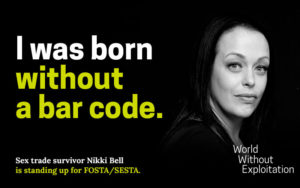At roughly 2:00 AM on a day in 1990, Patrick Trueman, then Chief of the Child Exploitation and Obscenity Section (CEOS) at the U.S. Department of Justice, was surprised to find himself stuck in a traffic jam. Where was the long line of vehicles ahead of him going at such an early hour? Into the heart of one of New York’s notorious red-light districts, that’s where.
On a ride-along with Frank Barnaba, founder of the Paul and Lisa Program (a nonprofit dedicated to combating child sex trafficking) and Robert Flores, Senior Trial Attorney with CEOS, Trueman was there to witness firsthand the open commercial sex exploitation of teenage girls and women in Manhattan’s Meatpacking District. By day, the district sold meat, produce, and dairy products. But by night, it transformed into a zone where traffickers pedaled another type of flesh—human flesh.
What Trueman saw broke his heart. “Vehicles would pull to the curb on either side of the street and young girls, some obvious minors, would get in, perform sex acts on one or more occupants, and then get out and move to the next vehicle,” Trueman recalls.
That night was the beginning of CEOS’ efforts to spur an FBI investigation into domestic minor sex trafficking in New York City. In those days, terms like “sex trafficking” weren’t even in use, and FBI officials viewed sexual exploitation of women and children dismissively. Despite numerous efforts on the part of CEOS, the FBI investigative support they hoped for never materialized.
Twenty-eight years later, Trueman is still fighting the commercial sexual exploitation of women and children as President and CEO of the National Center on Sexual Exploitation in Washington, DC. Now, the FBI investigates many cases of sex trafficking annually and a national movement to combat sex trafficking has grown and matured.
Even so, the battleground has shifted dramatically and the problem metastasized.
As Trueman explains, “Combating the sexual exploitation of women and children was a massive challenge in the 80s and 90s. As fraught with difficulty as it was, what we faced then was a drop in the bucket compared to sexual exploitation today.”
What caused this change? The Internet.

The Prostitution Marketplace in the Internet Age
In recent years, the throngs of men looking to buy people for sex no longer needed to drive around town under cover of darkness to find the “merchandise” they were seeking. Instead, men could shop anytime, anywhere, using their computers or cell phones. The prostitution marketplace in the Internet Age moved online where anonymity, societal indifference, and an archaic law—the Communications Decency Act —shielded the sex trade and allowed it to thrive.
Like any other “commodity,” the trading of people for sex operates on principles of supply and demand. Those who are bought and sold for sex constitute the “supply,” those who “distribute” the supply are sex traffickers (a.k.a. pimps), and those who make up the “demand” are the individuals with the desire, along with the ability and willingness, to purchase people in the prostitution (i.e., sexual exploitation) marketplace for their personal sex use.
Of course, the ability of the sexual exploitation marketplace to flourish hinges on the capacity of traffickers to deliver “the goods.” This is where Internet-based platforms saw an opportunity and seized it.
By providing online bulletin board-type advertising forums where sex traffickers could easily market their wares and set up appointments with the sex buying public, the men looking to buy people for sex no longer needed to line up in their cars to troll around “meat markets” at 2:00 AM.
Such websites made “prostitution shopping” easy. Like shopping for a used car, these websites made it possible for the buyers to easily pick the “color, make, model” of those being offered as public sexual commodities.
Encouraged by the seeming anonymity provided by the Internet, men who may have hesitated to ride around town looking for people to buy for sex a decade before, now felt emboldened. Moreover, as Internet availability spread from urban areas to smaller communities, so did the sex trade. No longer relegated to urban city centers, websites made the sexploitation marketplace accessible from one end of the country to another.
While some online platform owners supplemented their earnings by the provision of sex trade advertising, others—the most notorious of which was Backpage.com—developed business models built almost entirely on the facilitation of prostitution and sex trafficking. Illustrating this point, from the period of January 2013 to March 2015, 99% of Backpage’s global revenue was attributable to prostitution advertising. During this same period, Backpage made nearly $51 million in revenue from prostitution ads in California alone.
Likely the world’s largest prostitution facilitator, reports indicate “at its height [Backpage] had 943 location sites on six continents, operated in 97 countries and in 17 languages.” Thus, Backpage’s owners and operators were the functional equivalents of “mega-pimps” taking cuts off of prostitution transactions the world over via advertising fees. Whether big or small, operators of web-based companies profiting from the advertising of prostitution represent a corporate class of sex traffickers who sit at the apex of the global supply chain of sexual exploitation.
Despite Backpage’s major role in facilitating the global expansion of sexual exploitation and trafficking, for years the U.S. Department of Justice failed to prosecute, and courts repeatedly denied state authorities the ability to take action, and stripped sex trafficking victims of the right to sue those who facilitated their exploitation in civil court.
Why? The answer to that question hinges on a law passed more than 20 years ago.

The Communications Decency Act
In 1996, Congress was already wrestling with concerns that the Internet would become a major vehicle for making obscene material easily accessible to children. At the time, Nebraska Senator Jim Exon introduced the Communications Decency Act (CDA), saying, “the information superhighway should not become a red-light district”—a concern that was undoubtedly prescient. As anyone alive today can attest, we’re swimming neck deep in Internet pornography swill and websites offering people for sex have been Internet fixtures.
Despite Congress’ intentions in passing the CDA, something went terribly wrong.
That’s where Reno v ACLU comes in, the Supreme Court case which in 1997 struck down the majority of CDA and left standing a small provision known as Section 230. As explained on the website of the documentary film I Am Jane Doe (which delves into the legal battle by sex trafficking victims to sue websites that facilitated their sexual exploitation), although Congress intended for Section 230 to protect companies which try to filter content but don’t catch everything, that protection was expanded by federal judges to provide a website operator with full immunity, even if it knowingly engaged in criminal conduct! This has given Internet companies a considerable advantage over competitors like traditional print newspapers and magazines, as well as radio, businesses that are not afforded the same “privilege” of protection from liability even when knowingly facilitating crime.
FOSTA-SESTA
This was the situation until this past March when the U.S. Senate passed legislation known as FOSTA-SESTA by a vote of 97-2. The legislative package included H.R. 1865 the Allow States and Victims to Fight Online Sex Trafficking Act (FOSTA), sponsored by Rep. Ann Wagner (R-MO), and an amendment sponsored by Rep. Mimi Walters (R-CA) that incorporated the vital reforms contained in S. 1693 the Stop Enabling Sex Traffickers Act (SESTA), sponsored by Senators Rob Portman (R-OH) and Richard Blumenthal (D-CT). SESTA amended the Communications Decency Act to help fight online sex trafficking by restoring victims’ civil right of action and empowering state Attorneys General to prosecute websites that facilitate sex trafficking (important because jurisdiction on CDA enforcement was restricted to the U.S. Department of Justice only). FOSTA amends what is commonly known as the Mann Act to criminalize those who own, manage, or operate websites with the intent of promoting or facilitating the prostitution of others.
Within days of the U.S. Senate’s passage of the legislation, and before it had even been signed into law, Craigslist shuttered their “personal” ads, other prostitution Internet hubs like CityVice and Nightshift closed their sites, and The Erotic Review—the “Yelp” of the sex trade where men rated their experiences—shut down its U.S. boards.
Furthering the market disruption, in April the U.S. Department of Justice, after many years of inaction, seized and shutdown Backpage.com, and indicted seven individuals on 93 counts for several crimes related to Backpage.com.
Three months later, “The demand for commercial sex is at a new low for this decade and the state of the online prostitution marketplace is one of unreliability and fragmentation,” reports Rob Spectre, technical consultant for counter human trafficking. Spectre, who consults for law enforcement agencies across the country, sums up the impacts of the new law this way: “The online economy fueling human trafficking has never been more fragile than it is today. Post-FOSTA/SESTA, traffickers are making less money, website operators are making less money, buyers are purchasing less frequently and new victims are enduring fewer dates.”
For the time being at least, Congress has struck a blow against the online sex trafficking business model. However, the supporters of an unregulated Internet, major tech companies and their allies (who fought tooth and nail against CDA reform), and the promoters of organized sexual exploitation aren’t giving up without a fight. They’re taking the battle to the courts, having filed a lawsuit seeking to have FOSTA-SESTA declared unconstitutional.
It will be many months, if not years, before the outcome of this legal challenge plays itself out. One can only hope that the final verdict will not re-victimize survivors of sex trafficking by denying them the justice they deserve—to see those that facilitate and profit from their exploitation duly punished for their crimes.
In the meanwhile, voice your support for the principle that people aren’t products to be bought and sold online by sending this FOSTA-SESTA thank you email to your members of Congress: https://endsexualexploitation.org/cda/.
For more background information on the fight to amend the CDA see:
National Center on Sexual Exploitation
Coalition Against Trafficking in Women
The Villanova Law Institute to Address Commercial Sexual Exploitation



